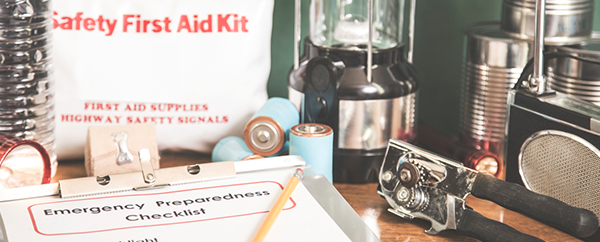It’s a new year and a fresh start. A great way to stay on the track for success in the new year is to make sure you have a natural disaster emergency response plan in place for your business. While maybe not the most exciting New Year’s resolution, it is important for management to spend time considering this topic in the context of your organization.
Over the past few years natural disasters have seen a startling uptick in frequency and severity across the country, from devastating wildfires to severe coastal storms, with resulting losses in the billions. Having a written plan in place to direct your employees both during and after a natural disaster can greatly improve the speed and likelihood of your organization’s recovery. Be sure to start 2021 off right by taking some time to either review or develop your natural disaster emergency response plan to ensure you are prepared for whatever the new year might bring.
Types of Natural Disasters
The Environmental Health and Safety (EHS) Natural Disaster Guide cites the following most common natural disasters and provides tips for how to prepare for them. When crafting a natural disaster emergency response plan, it’s always better to expect the unexpected.
Related: Natural disaster aftermath: Employee safety tips
Hurricanes
Coastal operations are more likely to experience hurricanes, but occasionally a far-reaching storm can wreak havoc much farther inland. In fact, “inland hurricanes” called derechos, though less common, should also be prepared for: One hit the Midwest in August 2020 and caused widespread damage with hurricane-like forces. Hallmarks of a hurricane include intense winds 74 mph or higher, driving rain and flooding, and sheer destructive force to infrastructure.
Tips:
- Appoint someone in your organization to regularly check weather and storm forecasts, especially during storm seasons.
- Have the adequate materials on hand to quickly stormproof your building if necessary, such as sandbags and plywood window covers.
- Refer to additional guidance from the National Oceanic and Atmospheric Administration (NOAA).
Wildfires
Devastating fires can be touched off in any number of ways, from an errant campfire spark to lightning strikes. Depending on weather conditions, available fuel and containment efforts, a single wildfire has the potential to burn millions of acres. It can destroy any infrastructure in its path and cut off escape routes for those trying to flee. Just a few months ago nearly all of the buildings in Malden, WA were destroyed by a fast-moving wildfire driven by high winds. Hazardous air quality from smoke can also cause widespread negative effects even hundreds of miles away.
Tips:
- Have your properties examined for fire risks by local experts. Consider any flammable materials that may be stored onsite and any vegetation and landscaping that may act as fuel during a wildfire.
- Regularly inspect and replace air filters to ensure they are working properly. Have extra supplies of filters and personal masks rated for wildfire smoke on hand in case of prolonged periods of intense smoke in your area.
Extreme Winter Weather
Most of us take winter weather in stride by bundling up and staying indoors, but sometimes winter is fiercer than we bargain for. In 2019 a polar vortex struck the Midwest, causing many operations to halt and approximately 20 cold-related deaths. Extreme winter conditions can cause unexpected volumes of snow and ice and plunging temperatures made more bitter by windchill. If it is cold enough, incidents that would not normally be so severe, such as a slip and fall on ice or passing out due to over-exertion can rapidly result in death by freezing. In addition, operating motor vehicles becomes especially hazardous or even impossible. Even during milder years or in areas where winter weather is not normally severe, winter conditions should always be approached with an abundance of caution and preparation.
Tips:
- If the forecast is predicting intense winter weather, consider shutting down operations early to allow your employees plenty of time to get home safely.
- Outdoor workers should be equipped with appropriate winter shoes and clothing, avoid over-exertion and be trained to avoid common winter injuries such as slips, trips and falls and frostbite.
Earthquakes
Preparing for earthquakes can present a significant challenge since they are typically unpredictable even in areas that are prone to them. In addition to causing widespread damage to infrastructure, earthquakes can also trigger additional disasters such as tsunamis, flash floods, fires, landslides or avalanches. Earthquakes can strike anytime, anywhere, with absolutely zero warning. Employees should be trained how to respond to an earthquake and educated on the best ways to quickly find adequate shelter. If you’re in a quake zone, it’s important to include any potential events triggered by an earthquake in your natural disaster emergency response plan.
Tips:
- Determine what, if any, earthquake resistant building materials or methods have been incorporated into your properties. Keep this information in mind when planning any building modifications, renovations or upgrades.
- Practice earthquake response drills with your team several times a year.
Related: Help clients minimize earthquake damage to commercial property
Floods
Similar to earthquakes, flooding can strike anytime, anywhere. They are a common additional occurrence to other types of disasters such as earthquakes and hurricanes. Flash floods often occur after wildfires, since the fire destroys vegetation that would normally absorb water from rainfall. Floods can also occur due to infrastructure failure, such as dams and water treatment plants.
Tips:
- Determine the flood risk to your properties, and at what water level your properties would be adversely affected.
- Try to store valuable materials that could be damaged in a flood, such as important papers, in waterproof containers in higher stories of your building, or at least several shelves up from the floor.
Also include in your natural disaster emergency response plan
Additional preparation that should be part of your disaster response plan should include:
Criteria
What conditions will trigger the implementation of your disaster plan protocols? These could include winds over a certain mph, air quality levels over a certain threshold, so many inches of rain in a 24-hour period, and so on. Remind employees that any evacuation orders and other guidance from local authorities will supersede your plan.
Evacuation routes and shelters
A primary, secondary and tertiary evacuation route and shelter location should be identified for every type of event your disaster plan covers.
Property Protection
Have protocols in place to protect valuable business property, such as electronics, data and documents. These protocols should only be undertaken when there is plenty of advance warning. Once evacuation or pre-evacuation orders have been given, protecting human life should be the main focus.
Timetables
Your natural disaster emergency response plan should include a timeline to help guide return-to-work efforts in the aftermath of a disaster. The timeline should include day-by-day checklists and instructions to guide employees in how to resume operations at a temporary location within a certain timeframe of disaster conditions abating.
Recovery
Include checklists for documenting and reporting damages and other losses to your broker or insurance carrier, including the appropriate contact information you will need.
If 2020 and 2021 taught us anything, it was that you can never be too prepared. For more information on natural disaster emergency response plans, check out the EHS Natural Disaster Guide.
This article was originally published on our Tribal blogpost. It has been modified and updated to better fit the needs of our ACM clients.

